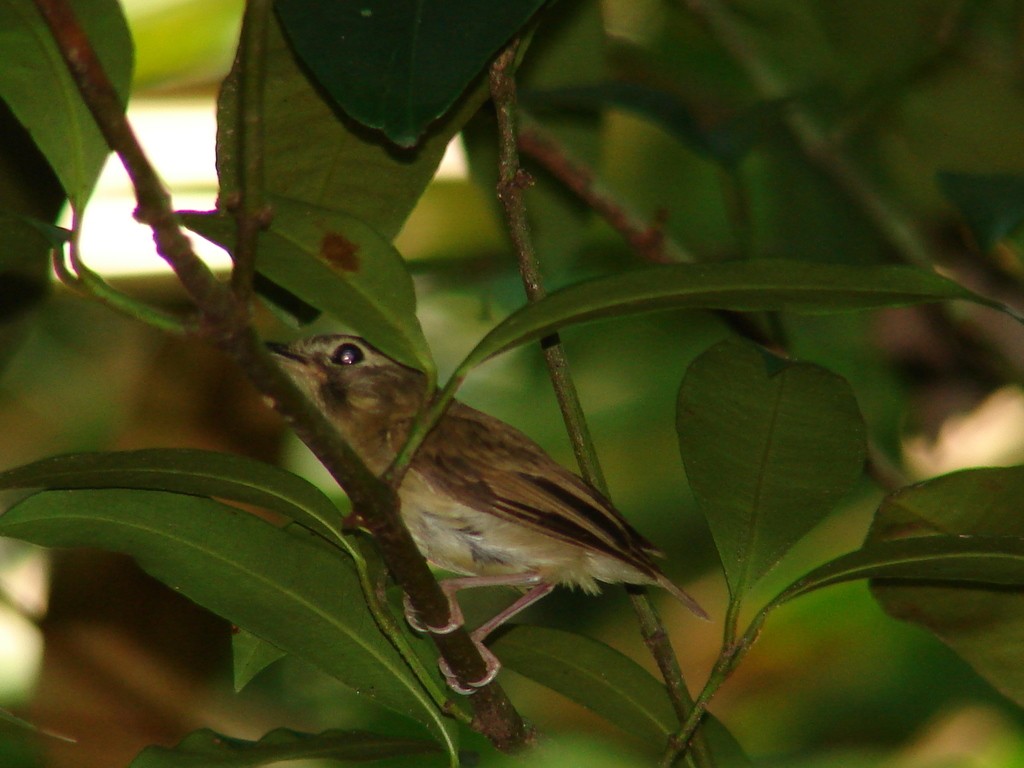Stub-tailed Spadebill
A species of Spadebills Scientific name : Platyrinchus cancrominus Genus : Spadebills
Stub-tailed Spadebill, A species of Spadebills
Botanical name: Platyrinchus cancrominus
Genus: Spadebills
Content
Description General Info
 Photo By alexpacheco , used under CC-BY-NC-4.0 /Cropped and compressed from original
Photo By alexpacheco , used under CC-BY-NC-4.0 /Cropped and compressed from original Description
The stub-tailed spadebill can grow up to 9.5 cm (3.74 in) long and weigh up to 12 g (0.42 oz). It has brown feathering on its head extending down to the mantle as well as its wings. It has a pale-coloured mandible leading to its white throat. The abdomen usually has yellow plumage in males, but females may have brown and yellow plumage as well. The short brown tail of the species is a distinguishing feature that gives it its name. Stub-tailed spadebill have a broad and flat bill and pinkish feet. It also has a distinguishable face pattern with distinctive yellow postocular stripes. One of the most discerning features of the species is its greatly reduced or completely absent crown. Unlike other members of the genus Platyrinchus, the stub-tailed spadebill does not have a crown, which led to it being identified as a separate species. Due to the colouring of its plumage, it has often been quoted to be ‘difficult to spot’ in its natural habitat. Alongside its slender body, it is able to avoid predators with this colouring that allows it to blend in. Stub-tailed spadebills can also be easily recognized by their nasal, rapid, and shaky “ki-di-di-di-rrril” calls that they often make after taking short flights. 
Size
10 cm
Nest Placement
Tree
Feeding Habits
Stub-tailed Spadebill predominantly consumes insects like homopteran bugs, ants, and beetles, as well as spiders. They supplement their diet with fruits. Stub-tailed Spadebill's foraging behavior involves actively searching for prey in foliage, exhibiting a preference for certain food types based on availability.
Habitat
Stub-tailed Spadebill can typically be found inhabiting the lower to middle strata of shady undergrowth within humid evergreen forests, as well as semi-deciduous, gallery, and dry forests. These birds are adapted to a range of altitudes but are generally present from sea level up to 1300 meters, with occurrences up to 1500 meters in some regions. Stub-tailed Spadebill occupies dense vegetation areas that provide ample cover and foraging opportunities within these forested habitats across broad geographical regions of tropical and subtropical zones.
Dite type
Insectivorous
General Info
Feeding Habits
Bird food type
Behavior
The stub-tailed spadebill may be found alone or in pairs. It will look around for food in the undergrowth it inhabits. It feeds on fruits, seeds, and insects such as ants and beetles. As it occupies the lower levels of the rainforest, it feeds on the small drupes and berries growing at this level. The stub-tailed spadebill also benefits from its habitat amongst the undergrowth of the tropical rainforests as it is able to scavenge dead grass and plant fibers for nesting. During the breeding season, individuals of the species in Costa Rica have been seen to scavenge grasses and plant fibres to make deep, cone-shaped cup nests. These nests are often placed in low saplings around the scavenging sites. Despite having access to a variety of different food sources, it is also seen that some individuals may exclusively feed only on plants. It may also change its preferences between fruits and seeds depending on the abundance of either. Stub-tailed spadebills are also commonly involved in mixed-species feeding flocks in which birds of different species forage together. This behaviour may be taken to reduce the risk of predation due to increased vigilance. Stub-tailed spadebills mainly forage alongside species like tanagers, flycatchers, and warblers. The stub-tailed spadebill is able to sustain and forage for food in its trophic niche despite the presence of other competing species due to this flocking behaviour as individuals from all species collectively hunt. 
Distribution Area
Stub-tailed spadebills are commonly observed in tropical dry forests and subtropical moist forests ranging from southern Mexico to parts of Belize, Guatemala, Honduras, Nicaragua, and Costa Rica, covering about 1,090,000 km of land. The habitat of the stub-tailed spadebills stretches over a large range of Central America and has intersections with other related species. It is known to occupy spaces within altitude limits of 0 – 1500 m above sea level. It occupies the undergrowth of the tropical forests to accommodate its food choices as well for protection from predators. Despite the lack of previous populations in the region, individuals of the species were also found to also inhabit forests in North-western Panama in recent studies showing that the species is able to disperse over a greater area than previously thought and is also able to occupy islands with new regrowth, showing dispersal over water. These populations are thought to be remnants from a time when the species had a greater range of habitat. The current population is estimated to currently be around 50,000 – 500,000 individuals. However, a decreasing trend has been observed in the population. This decreasing trend in population is expected to be due to deforestation and fragmentation of land, resulting in the destruction of the typical humid rainforests the stub-tailed spadebills normally inhabit. But this decline is not sufficiently rapid to approach thresholds to be treated as vulnerable. As such, it is currently not considered a threatened species by the IUCN. This species is found amongst the foliage of the rainforests with shrubs, and trees with canopies up to medium height. Some species of foliage commonly in such forests are Rubiaceae, Phyllanthaceae, hemiepiphyte, and epiphytes. This kind of undergrowth gives the stub-tailed spadebills the ability to perch directly above prey hidden in the foliage. 
Scientific Classification
Phylum
Chordates Class
Birds Order
Perching birds Family
Tyrant flycatchers Genus
Spadebills Species
Stub-tailed Spadebill